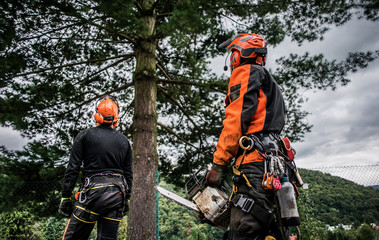You might not realize how much expertise goes into caring for the trees in your community.
Arborists and tree care professionals possess unique skills that help keep our urban ecosystems thriving.
Their journeys often start with a deep-rooted passion for nature and develop into specialized knowledge in tree health and management.
Curious about what they do day-to-day and the impact they have?
Let’s explore their vital role in our environment.
The Journey to Becoming an Arborist
Becoming an arborist is rewarding for those passionate about trees who want to contribute to a healthier environment. It requires a combination of education, training, and hands-on experience.
Education and Training
- Formal Education: A degree in horticulture, forestry, arboriculture, or a related field can provide a strong foundation in tree biology, ecology, and tree care principles.
- Hands-on Experience: Apprenticeships, internships, or entry-level positions with established arboriculture companies offer invaluable practical experience in tree care techniques, including climbing, pruning, and removal.
Skill Development
- Tree Identification: Learn to identify different tree species, their growth habits, and their specific care requirements.
- Tree Assessment: Develop the ability to assess tree health, identify diseases and pests, and evaluate potential hazards.
- Pruning Techniques: Master various techniques, including crown reduction, thinning, and deadwooding.
- Climbing and Safety: Acquire the skills and knowledge necessary for safe and efficient tree climbing and aerial work.
Certification and Professional Development
- Industry Certifications: Obtain certifications from recognized organizations such as the International Society of Arboriculture (ISA).
- Continuing Education: Participate in workshops, seminars, and conferences to stay updated on the latest industry best practices, new technologies, and safety regulations.
Personal Qualities
- Passion for Trees: A genuine love for trees and a desire to protect and preserve them.
- Physical Fitness: The ability to perform physically demanding tasks, including climbing, lifting, and working outdoors in various weather conditions.
- Problem-Solving Skills: The ability to diagnose tree problems accurately and develop practical solutions.
- Communication and Interpersonal Skills: Strong communication skills to effectively interact with clients, explain recommendations, and build relationships.
- Commitment to Safety: A strong emphasis on safety for oneself and others while working around trees.
Becoming a successful arborist requires dedication, hard work, and a continuous commitment to learning and professional development. Aspiring arborists can build a rewarding career in this fulfilling profession by combining formal education with practical experience and a commitment to safety and excellence.
Specializations and Services Offered
Tree Assessments:
- Arborists thoroughly assess tree health, identifying potential problems such as diseases, pests, structural weaknesses, and decay.
- They evaluate the risk of trees causing damage to property or posing a danger to people.
Tree Removal:
- Arborists safely remove trees using specialized techniques that minimize disruption to your property.
- They consider tree size, location, and surrounding structures to ensure a safe and efficient removal process.
Pruning:
- Structural Pruning: Improves tree structure, enhances air circulation, and reduces the risk of breakage.
- Thinning: Removes selected branches to reduce density and improve light penetration.
- Deadwooding: Removes dead, dying, or diseased branches to improve tree health and safety.
Tree Care:
- Fertilization: Recommends and applies appropriate fertilizers to improve tree health and vigor.
- Soil Improvement: Improves soil conditions to enhance tree growth and development.
- Pest and Disease Management: Identifies and treats various tree diseases and pests using environmentally friendly and effective methods.
Specialized Services:
- Cabling and Bracing: Supports weak branches with cables and braces to improve structural stability and prevent breakage.
- Tree Planting and Transplanting: This position assists with proper tree planting and transplanting techniques, ensuring the trees establish themselves successfully in their new locations.
Arborists offer a wide range of specialized services and play a crucial role in maintaining the health, beauty, and safety of trees in our communities.
A Day in the Life of a Tree Care Professional
A typical day for a tree care professional is dynamic and fulfilling. It involves a variety of tasks that require skill, precision, and a passion for trees.
Morning:
- Tree Assessments: The day often begins with thoroughly inspecting trees, assessing their health, identifying potential hazards, and noting any signs of disease or pest infestation.
- Pruning: Perform techniques such as removing deadwood, thinning branches, and shaping trees to improve their structure and health.
Midday:
- Equipment Operation: Operate specialized equipment such as chainsaws, chippers, and aerial lifts, ensuring safe and efficient operation.
- Safety Protocols: Always adhere to strict safety protocols, including wearing appropriate safety gear and following proper tree climbing and rigging techniques.
Afternoon:
- Client Communication: Consult with clients, explain findings and recommendations, and answer any questions they may have.
- Record Keeping: Document work performed, including tree assessments, pruning details, and other relevant information.
- Planning and Preparation: Plan for upcoming jobs, including scheduling appointments, ordering necessary materials, and ensuring that all equipment is in proper working order.
Throughout the Day:
- Teamwork and Collaboration: Collaborate with other team members, sharing knowledge and expertise.
- Continuous Learning: Stay updated on industry best practices, new technologies, and safety regulations.
Each day brings unique challenges and rewards, allowing tree care professionals to connect with nature, contribute to the health of our urban forests, and positively impact the environment.
The Impact of Arborists on Urban Ecosystems
Arborists play a crucial role in maintaining the health and balance of urban ecosystems.
Key Impacts:
- Improved Air Quality: Trees absorb pollutants from the air, improving air quality for urban residents.
- Reduced Heat Island Effect: Trees provide shade, cooling urban areas and mitigating the “heat island effect,” in which urban areas are significantly warmer than surrounding rural areas.
- Enhanced Biodiversity: Trees provide valuable habitat for a wide range of wildlife, including birds, insects, and small mammals, fostering a rich biodiversity within urban environments.
- Improved Water Quality: Tree roots help stabilize soil, reduce erosion, and enhance water quality in urban waterways.
- Increased Property Values: Mature trees can significantly increase property values.
- Enhanced Aesthetics: Trees enhance the visual appeal of urban landscapes, creating a more pleasant and inviting environment.
- Community Education: Arborists educate the public about the importance of trees, encourage responsible tree care, and promote urban forestry initiatives.
Arborists are vital stewards of urban ecosystems. Their expertise and dedication contribute to healthier, more sustainable, and more livable cities.
Arborists play a vital role in maintaining the health and vitality of our urban forests. They contribute to a healthier, more sustainable, and more livable urban environment through their specialized knowledge, dedication to safety, and commitment to environmental stewardship.
By understanding and appreciating the valuable work of these skilled professionals, we can all contribute to supporting and preserving the urban trees that enrich our lives.

